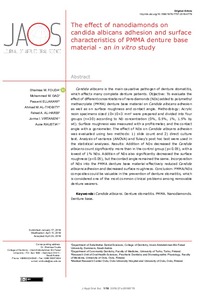The effect of nanodiamonds on candida albicans adhesion and surface characteristics of PMMA denture base material - an in vitro study
Passent Ellakany; Ahmad M. Al-Thobity; Fahad A. Al-Harbi; Jorma I. Virtanen; Shaimaa M. Fouda; Mohammed M. Gad; Aune Raustia
https://urn.fi/URN:NBN:fi-fe2021042825124
Tiivistelmä
Candida albicans is the main causative pathogen of denture stomatitis,
which affects many complete denture patients. Objective: To evaluate the
effect of different concentrations of nanodiamonds (NDs) added to polymethyl
methacrylate (PMMA) denture base material on Candida albicans adhesion
as well as on surface roughness and contact angle. Methodology: Acrylic
resin specimens sized 10×10×3 mm3 were prepared and divided into four
groups (n=30) according to ND concentration (0%, 0.5%, 1%, 1.5% by
wt). Surface roughness was measured with a profilometer, and the contact
angle with a goniometer. The effect of NDs on Candida albicans adhesion
was evaluated using two methods: 1) slide count and 2) direct culture
test. Analysis of variance (ANOVA) and Tukey’s post hoc test were used in
the statistical analyses. Results: Addition of NDs decreased the Candida
albicans count significantly more than in the control group (p<0.05), with a
lowest of 1% NDs. Addition of NDs also significantly decreased the surface
roughness (p<0.05), but the contact angle remained the same. Incorporation
of NDs into the PMMA denture base material effectively reduced Candida
albicans adhesion and decreased surface roughness. Conclusion: PMMA/NDs
composites could be valuable in the prevention of denture stomatitis, which
is considered one of the most common clinical problems among removable
denture wearers.
Kokoelmat
- Rinnakkaistallenteet [19207]
